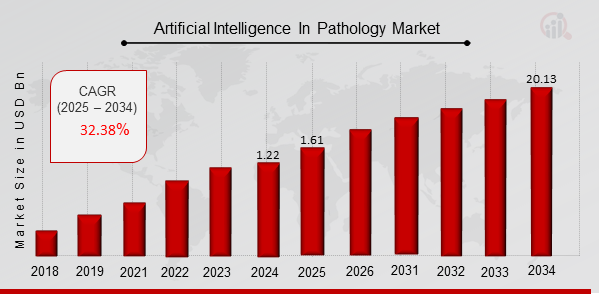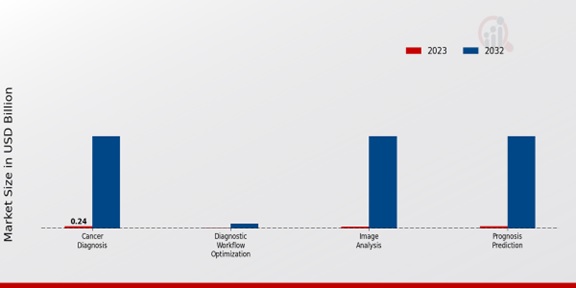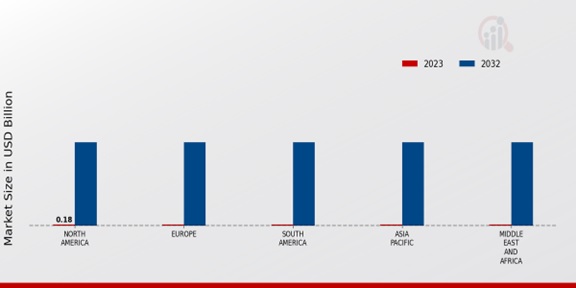Global Artificial Intelligence (AI) In Pathology Market Overview
As per MRFR analysis, the Artificial Intelligence (AI) In Pathology Market Size was estimated at 1.22 (USD Billion) in 2024. The Artificial Intelligence (AI) In Pathology Market Industry is expected to grow from 1.61 (USD Billion) in 2025 to 20.13 (USD Billion) till 2034, at a CAGR (growth rate) is expected to be around 32.38% during the forecast period (2025 - 2034).
Key Artificial Intelligence (AI) In Pathology Market Trends Highlighted
Artificial Intelligence (AI) is revolutionizing the field of pathology, driving the development of innovative diagnostic tools and improving patient outcomes. The global AI in pathology market is projected to reach USD 11.5 billion by 2032, with a CAGR of 32.38%.
Chronic diseases continue to be on the rise with increasing demand for personal healthcare and the growing availability of computing. This has resulted in a great embrace of AI-empowered pathology solutions that are dedicated to helping pathologists diagnose, anticipate medical consequences and deliver therapeutic interventions.
Development of AI algorithms for early disease detection, individualized treatment choice and provision of remote pathology services offer areas for exploration. An integration of AI with other technological platforms like machine learning as well as deep learning are among the emerging trends in recent years. Moreover, there is growing attention being paid to AI-supported workflows, which would streamline different stages involved in pathology and improve overall laboratory efficiency.

Source: Primary Research, Secondary Research, MRFR Database and Analyst Review
Artificial Intelligence (AI) In Pathology Market Drivers
Increasing Adoption of AI in Healthcare
The adoption of artificial intelligence (AI) in healthcare is the key driver to increasing growth in global artificial intelligence in the pathology market industry. Besides, AI can create a difference in pathology practice by automating tasks, increasing precision and introducing novel perspectives on disease diagnosis and prognosis. For example, there are algorithms that use AI to scrutinize images of pathology so as to reveal things that a human being might not see.
This would help pathologists make more precise diagnoses as well as detecting diseases at an earlier stage. Furthermore, AI can support personalized care through the development of new medications and treatments for individual patients. As such, it is anticipated that there will be a high demand for AI-driven pathology solutions, given the increased adoption of AI within the health sector.
Rising Prevalence of Chronic Diseases
There are chronic illnesses such as diabetes, tumors or cardiovascular ailments that are among the most common causes of death and disability worldwide. These diseases often have complicated diagnostic procedures, making them hard to diagnose and treat. As a result, they can be automated using AI and have their prognosis, as well as diagnosis, improved thereby improving patient outcomes. AI-powered algorithms enable pathologists to examine pathology images in order to detect patterns that cannot be seen by the naked eye, for instance.
This would facilitate more accurate diagnoses by pathologists and earlier detection of illnesses. Moreover, it allows the creation of new drugs and methods based on AI and personalization of care according to each individual case.
Government Initiatives to Promote AI in Healthcare
The growth of Global Artificial Intelligence In the Pathology Market Industry is also propelled by government initiatives to promote AI in healthcare. Governments across the globe are realizing the potential of AI in enhancing health outcomes and reducing costs. For this reason, they invest in actions that promote its application and formation within the health care systems. As an illustration, the US government has several initiatives to promote AI in health, including the AI for Health Initiative and Precision Medicine Initiative.
In addition, these initiatives are offering funding for research, development and deployment of AI. Furthermore, governments are also developing laws on how to use AI in the medical field that will aid in ensuring the safe and ethical use of AI.
Artificial Intelligence (AI) In Pathology Market Segment Insights
Artificial Intelligence (AI) In Pathology Application Insights
Pathology practice's efficiency and accuracy are greatly enhanced by the applications. The applications include cancer diagnosis, diagnostic workflow optimization, image analysis, prognosis prediction, and treatment selection.
Cancer Diagnosis: Digital pathology images are analyzed by AI-powered systems helping pathologists to diagnose cancer more accurately. Subtle patterns and abnormalities that the human eye could miss can be detected by them, ultimately leading to early and precise diagnoses.
The growth of the AI-based cancer diagnosis market is being driven by the increasing adoption of digital pathology and the increasing incidence of cancer.
Diagnostic Workflow Optimization: Pathologists’ time can be freed up from tasks such as slide preparation, image annotation, and report generation through AI algorithms capable of automating repetitive ones. By optimizing workflows, AI can enhance efficiency while reducing turnaround times for pathology reports. The demand for delivering timely and accurate results in pathology laboratories has been increasing, hence fueling the adoption of AI-based workflow optimization solutions.
Image Analysis: AI’s training includes qualitative data extraction of the number of cells, nuclear size and tissue density from pathology images. This information is critical when it comes to understanding how the disease is developing or responding to treatment, thereby making informed decisions. The AI-based image analysis market is taking shape due to increasing demand for objective and reproducible image analysis.
Prognosis Prediction: The risk of disease recurrence, progression and response to therapy can be predicted by utilizing patient-specific data, including pathology images, clinical history, as well as molecular profiles using artificial intelligence tools.
This knowledge helps doctors when planning treatments for patients more effectively ultimately improving outcomes. Large-scale medical datasets are increasingly available alongside improved machine learning techniques, which have become major drivers in the growth of the AI-based prognosis prediction industry.
Treatment Selection: Depending on the pathological information of patients, AI can be used to help determine the most suitable treatment options. For example, it can analyze tumor characteristics and predict their response to different therapies, thus enabling doctors to make better choices about treatments for patients.
The growing interest in tailored medicine, accompanied by a need for more accurate therapeutic approaches, has created a fertile ground for an AI-driven treatment selection sector. Artificial Intelligence (AI) In Pathology Market Revenue for the Application segment is anticipated to show significant growth during the forecasted period because of the rising adoption rate across all pathology labs worldwide.

Source: Primary Research, Secondary Research, MRFR Database and Analyst Review
Artificial Intelligence (AI) In Pathology Type of Analysis Insights
Artificial Intelligence (AI) In Pathology Market has been segmented by Type of Machine learning; deep learning, Image recognition, Natural language processing and Predictive analytics are some of the most popular types of machine learning techniques. In terms of size, Machine Learning dominated the market in 2023 and is anticipated to remain dominant throughout 2025-2034. Growing demand for disease classification using machine-learning algorithms has greatly contributed to this subsegment’s rapid expansion, as well as the adoption of pattern recognition and image analysis tasks in pathology.
Moreover, deep learning, which is a sub-category of machine learning is gaining popularity among end users on account of its ability to represent complex data sets and provide relevant findings.
Another vital segment is Image Recognition, which has got its applications in pathology, including tissue segmentation, cell counting and tumor detection. Moreover, Natural Language Processing (NLP) and Predictive Analytics are anticipated to experience substantial growth during the next five years on account of NLP facilitates pathologists’ access to non-structured data while predictive analytics will enable them to derive decisions from it.
Artificial Intelligence (AI) In Pathology End User Insights
Pathology laboratories are expected to hold the largest market share due to the increased employment of AI-enabled image analysis and diagnostic tools, while Hospitals also look as they seek to improve patient care and streamline operations. Research institutes would be the major drivers of innovation in AI technology in pathology, while biotechnology and pharmaceutical companies would focus on AI-based drug discovery and development.
Through this, a large portion of the Artificial Intelligence (AI) In Pathology Market’s end-user base can be differentiated into research institutions, path labs, hospitals, academic institutions and biotech or pharma companies. Even so, the majority of these users will come from path labs because of the increasing use of AI-powered imaging analysis aids for diagnosis. Another important consumer group that is also likely to adopt AI technology significantly is hospitals seeking improved quality control on patients’ lives.
Henceforth, it is anticipated that personal medicine needs, together with studies related to Artificial Intelligence (AI) In Pathology as well as increasing adoption rates for AI within this field, shall result in a significant growth that will see academic institutions participating actively in training coming generations of these experts.
Artificial Intelligence (AI) In Pathology Regional Insights
The geographical distribution and potential growth of the market can be understood by the regional segmentation of the Artificial Intelligence (AI) In Pathology Market. Factors like the presence of main players, the high rate of advanced healthcare technologies adoption and government initiatives to promote AI development are expected to lead North America in this market. Europe is also expected to come next with a strong healthcare infrastructure and an increasing focus on precision medicine. Moreover, APAC is estimated to have substantial expansion as a result of the increased number of chronic diseases, spending on health care increases as well as governments in favor of adopting AI.
These regions are gradually embracing AI in order to improve healthcare access and enhance efficiency; therefore, South America and MEA might witness continuous growth.

Source: Primary Research, Secondary Research, MRFR Database and Analyst Review
Artificial Intelligence (AI) In Pathology Market Key Players And Competitive Insights
Major players in the Artificial Intelligence (AI) In the Pathology Market industry are constantly focusing on developing innovative products and solutions for the changing needs of the healthcare sector. Additionally, they are investing heavily in research and development to improve the accuracy and efficiency of AI-powered pathology tools. The Leading Artificial Intelligence (AI) In Pathology Market companies also engage in strategic partnerships, collaborations as well as acquisitions that help them extend their market reach and strengthen their competitive standpoints. New startups have emerged in the Artificial Intelligence (AI) Pathology Market, offering specialized AI solutions for pathology.
Paige.AI, Invicro, and PathAI are some remarkable players in the Artificial Intelligence (AI) In Pathology Market. Paige.AI has a comprehensive platform for image analysis, diagnostics and computational pathology as a leader in AI-powered pathology solutions. Invicro offers various AI-enabled products used in pathology applications due to its expertise in quantitative imaging. Another prominent player is PathAI, which specializes in developing AI algorithms for cancer diagnostics and has formed partnerships with major academic institutions and hospitals. Through inventive offerings and strategic initiatives by these companies, among other key players, drive artificial intelligence in the Pathology Market.
Other notable competitors include Indica Labs, Inspirata, and Leica Biosystems, among others in the Artificial Intelligence (AI) In Pathology Market industry. Among other products HALO platform is one of Indica Labs’ range of tissue image analysis powered by AI technologies. Inspirata provides cloud-based digital pathology platforms along with assistance from artificial intelligence systems. Aperio Al is an AI platform introduced into this market by Leica Biosystems, which majors in the provision of microscopy as well as pathological solutions. These companies are actively involved in research and development activities, product launches as well as strategic alliances to maintain their leadership positions while satisfying growing demands for AI driven pathology services.
Key Companies in the Artificial Intelligence (AI) In Pathology Market Include:
- Koninklijke Philips N.V.
- Arterys
- AI
- Invicro
- Siemens Healthcare
- NVIDIA
- 3DHISTECH
- AI Medical Service Inc.
- General Electric
- PathAI
- Inspirata
- GE Healthcare
- Roche
- IBM
- Visage Imaging
Artificial Intelligence (AI) In Pathology Market Industry Developments
The Artificial Intelligence (AI) In Pathology market has witnessed significant advancements and developments in recent years. In 2023, the market is valued at approximately USD 0.92 billion and is projected to reach USD 11.5 billion by 2032, exhibiting a CAGR of 32.38%. This growth is attributed to the increasing adoption of AI-powered pathology solutions, which offer benefits such as improved diagnostic accuracy, efficiency, and cost-effectiveness. Key players in the market include Roche, Siemens Healthineers, and Leica Biosystems, among others.
Strategic collaborations and acquisitions have been prevalent, such as the partnership between PaigeAI and Philips in 2023 to develop AI-based cancer diagnostics. Furthermore, government initiatives and investments in digital pathology and AI research are driving market growth. The market is expected to witness continued expansion as AI technologies become more sophisticated and integrated into pathology workflows.
Artificial Intelligence (AI) In Pathology Market Segmentation
Artificial Intelligence (AI) In Pathology Offering Outlook
Artificial Intelligence (AI) In Pathology Application Outlook
- Drug Discovery
- Disease Diagnosis & Prognosis
- Clinical Workflow
- Others
Artificial Intelligence (AI) In Pathology Technology Outlook
- Machine Learning
- Deep Learning
- Image Recognition
- Natural Language Processing
- Predictive Analytics
Artificial Intelligence (AI) In Pathology Indication Outlook
- Cancer
- Infectious Disease
- Autoimmune & Inflammatory Disease
- Neurology Disorders
- Others
Artificial Intelligence (AI) In Pathology End User Outlook
- Pharmaceutical & Biotechnology Companies
- Hospitals & Diagnostic Centers
- Academic & Research Institutes
- Others
Artificial Intelligence (AI) In Pathology Regional Outlook
- North America
- Europe
- South America
- Asia Pacific
- Middle East and Africa
| Report Attribute/Metric |
Details |
|
Market Size 2024
|
1.22 (USD Billion)
|
|
Market Size 2025
|
1.61 (USD Billion)
|
|
Market Size 2034
|
20.13 (USD Billion)
|
|
Compound Annual Growth Rate (CAGR)
|
32.38 % (2025 - 2034)
|
|
Report Coverage
|
Revenue Forecast, Competitive Landscape, Growth Factors, and Trends
|
|
Base Year
|
2024
|
|
Market Forecast Period
|
2025 - 2034
|
|
Historical Data
|
2020 - 2024
|
| Market Forecast Units |
USD Billion |
| Key Companies Profiled |
Koninklijke Philips N.V., Arterys, Paige.AI, Invicro, Siemens Healthcare, NVIDIA, 3DHISTECH, AI Medical Service Inc., General Electric, PathAI, Inspirata, GE Healthcare, Roche, IBM, Visage Imaging |
| Segments Covered |
Application, Type of Analysis, Pathology Type, End User, Modality, Regional |
| Key Market Opportunities |
Automated analysis personalized medicine drug discovery remote pathology workflow optimization |
| Key Market Dynamics |
Growing adoption of AI in healthcare Increasing demand for personalized medicine Government initiatives and funding Technological advancements in AI algorithms Strategic partnerships and collaborations |
| Countries Covered |
North America, Europe, APAC, South America, MEA |
Frequently Asked Questions (FAQ) :
The Artificial Intelligence In Pathology Market was valued at USD 1.22 billion in 2024 and is expected to reach a value of USD 20.13 billion by 2034, at a CAGR of 32.38% over the forecast period (2025-2034).
North America is expected to hold the largest share of the Artificial Intelligence In Pathology Market, with a share of 38.5% in 2023. The presence of major market players and the high adoption of AI technologies in pathology in the region are key factors driving the growth of the market in North America.
Key applications of Artificial Intelligence in Pathology include: - Cancer detection and diagnosis - Tissue analysis and classification - Prognosis prediction - Treatment planning - Drug discovery.
Key competitors in the Artificial Intelligence In Pathology Market include: - Google LLC - IBM Corporation - Microsoft Corporation - PathAI - Paige.AI - Insilico Medicine - Arterys - ContextVision - Zebra Medical Vision.
The Artificial Intelligence In Pathology Market is expected to grow at a CAGR of 32.38% from 2023 to 2032.
Key factors driving the growth of the Artificial Intelligence In Pathology Market include: - Increasing demand for personalized medicine - Rising prevalence of chronic diseases - Growing adoption of AI technologies in healthcare - Government initiatives to promote AI in healthcare.
Challenges faced by the Artificial Intelligence In Pathology Market include: - Lack of skilled professionals - Data privacy and security concerns - Regulatory hurdles.
Opportunities for the Artificial Intelligence In Pathology Market include: - Development of new AI algorithms and technologies - Increasing investment in AI research and development - Growing adoption of AI in clinical practice.
Key trends in the Artificial Intelligence In Pathology Market include: - Integration of AI with other technologies, such as machine learning and deep learning - Development of AI-powered virtual assistants - Increasing use of AI for remote pathology services.
Potential risks associated with the Artificial Intelligence In Pathology Market include: - Bias in AI algorithms - Lack of transparency in AI decision-making - Cybersecurity risks.

















